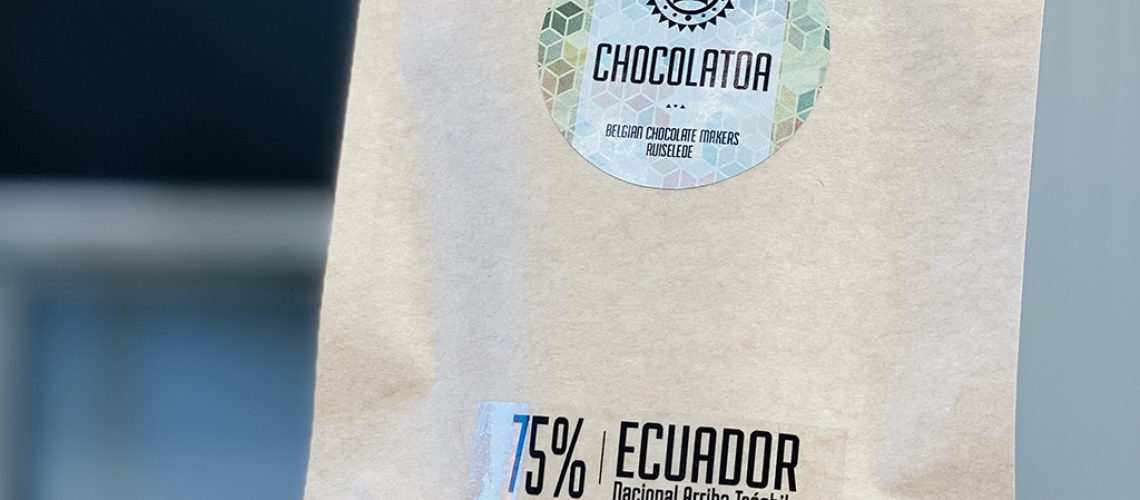Since 2015, Chocolatoa has been producing bean-to-bar chocolate that is both artisanal and ethical. But the Belgian chocolate maker also shares its expertise through training and professional advice, led by its founder, Mario Vandeneede.
After completing his chocolate-making studies in Mechelen, Mario Vandeneede spent some time in Ecuador. There he taught chocolate processing at the University of San Francisco in Quito and also looked after a cocoa plantation. Although the idea of making chocolate from cocoa beans alone was born at that time, the chocolate maker had to wait another ten years before his dream came true. “In 2015, at a trade fair, I finally met a manufacturer who could supply me with a quality machine at a good price.
That was the beginning of the Chocolatoa story,” recalls Mario Vandeneede. “A lot of bean-to-bar chocolate manufacturers start out with the idea of shaking things up in the sector, but without necessarily having the required skills or experience at the outset. I want to make a difference too, but I think it’s important to have a background in chocolate making first. I know how to work with chocolate, having taught it for years in almost every bakery/pastry school in the country. Then, little by little, I started producing by the kilo, then in tens, and so on, until I was able to produce about a hundred kilos a week in my current workshop”. Every year, Chocolatoa produces around 6,000 bars of chocolate under its own brand name and sells them through various channels: its web shop (closed during the summer months because of the heat), one or two local supermarkets, the Brussels shop specialising in Brigitte fine chocolates, and at events such as fairs and exhibitions. Finally, the manufacturer also works on behalf of a dozen other small brands, which entrust it with the production of their chocolates.
Organic and fair trade, but not necessarily certified
The reputation of Belgian chocolate is, of course, an undeniable asset when it comes to marketing such products, especially abroad. However, even though his chocolates regularly win prizes in international competitions, Mario Vandeneede is not necessarily proud of this attribute. “If you go to the Netherlands, for example, you can’t help but be delighted. Everyone wants to try Belgian chocolate. But how can I put it diplomatically? Belgian chocolate is a tradition, it has a history… But just because a chocolate, even a bean-to-bar chocolate, is made in Belgium doesn’t mean it’s better than any other. It’s mainly thanks to the hard work of the cocoa farmers, the cooperatives that put a lot of time and effort into making sure the beans are fermented to the highest quality, and so on. That’s why I think it’s important that the cocoa I use is fair trade and organic, even if it doesn’t necessarily have to carry the labels”.
But without certification, how can the founder of Chocolatoa be sure that these two criteria are met? “By visiting the plantations, either myself or through someone I trust. That’s why I only work directly with a producer or exclusively via Silva Cacao, an importer of speciality cocoa whose slogan is ‘Cacao with an identity’.” Unlike the modest manufacturer, Silva Cacao is certified ‘fair trade’ and ‘organic’. And while not all the cocoa offered by the importer has these labels, all the products nevertheless comply with the principles of fair trade laid down by the World Fair Trade Organization and are organically grown. As for the prices paid to producers, Silva Cacao explains on its website that, since the company only buys speciality beans, they are systematically higher than the Fairtrade minimum price. “What’s more, every cocoa bean I buy from Silva has a sort of identity card that can be accessed online, giving details of its exact geographical origin, how the community that produces it works, its aromatic characteristics, and so on. It’s very transparent. And if I want to know any other details, Silva Cacao is able to provide them,” adds Mario Vandeneede. “What’s more, many of the cocoas I work with also feature on the ‘Mapa de Sabores de Cacao’ project website”. This ‘flavour map’, which is a tool developed as part of the Maximizing Opportunities for Coffee and Cocoa in the Americas (MOCCA) programme funded by the USDA, the United States Department of Agriculture, lists many of the cocoa beans in the Americas according to their flavour profile, post-harvest process, etc. “I think this kind of initiative is a real game-changer. As a chocolate maker, you benefit from a high degree of transparency, you know the GPS coordinates of the plantation, who works there, what standards are respected…”.
More than a chocolate factory…
Mario Vandeneede’s concern for the sourcing and sustainability of his cocoa is not only expressed in the chocolate he makes, because making and selling chocolate is only one facet of Chocolatoa. “While it’s very important for me to always know where the beans I use come from, our philosophy is also to share this knowledge”. And the small company does this in many ways. “Chocolatoa is more than just a chocolate factory; it’s also an academy that teaches people how to make chocolate efficiently on a small scale, using very high-quality products. And for me, quality means knowing where the beans come from, the conditions under which they were grown, the fermentation protocol, etc. In addition to our teaching activities, we also provide consultancy services to various clients, as well as laboratory services, i.e. we produce chocolate samples with the aim of improving cocoa quality. This is important because if a cocoa farmer can produce better cocoa, he can charge a better price for it and therefore improve his income and standard of living”.
More than chocolate…
Although they may seem very different, these various activities share a common goal. “For me, it’s about making an impact and not necessarily counting the number of bars I sell,” continues the chocolatier. “Impact is measured more by the number of people you manage to reach with your story and whose point of view on consumption you manage to change”. And on this point, Mario Vandeneede’s vision is very clear. “Chocolate should no longer be seen as a sweet or an ordinary candy, but as a luxury product, just like wine. You can find very cheap bottles for 2 euros and grands crus for 30 euros, 100 euros or even more. It’s the same with chocolate, there are different qualities and we need to educate the consumer so that they are aware of this and can appreciate it. If we can do that, then we can really make a difference.”
However, there is still a lot of work to be done by the sector in this area, including by Mario Vandeneede himself, he admits. “I’m 100% sure that what I buy is sustainable, but I need to do even more to improve my knowledge of the issues that plague the sector. I also need to do a better job of communicating with my customers about the differences between ordinary chocolate with no traceability and genuinely high-quality chocolate.”


